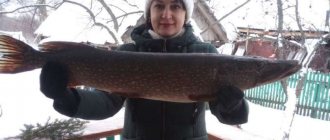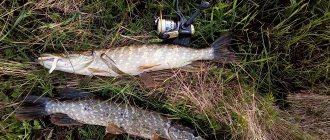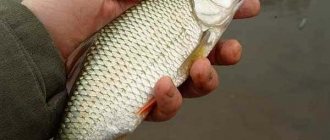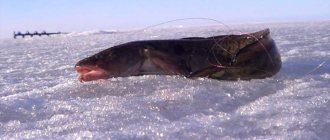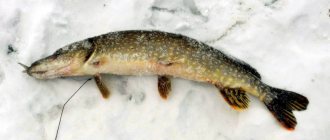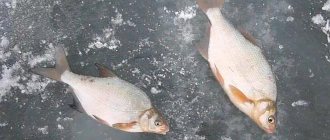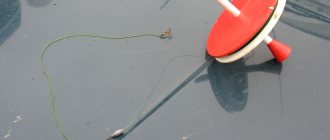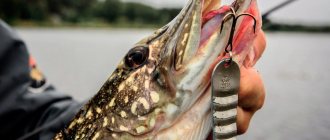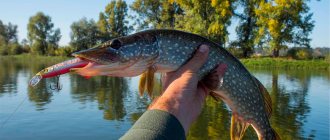Fishing time
Sabaneev also noted that pike feed at long intervals and one of its feeding periods occurs before spawning. Further, the classic wrote: “These periods vary depending on the terrain and climate, and its zhor is almost unnoticeable, since at this time it has no shortage of food and does not go well with fishing rods and girders: millions of young fish are teeming everywhere.” Here it should be added that in March the toothy predator goes well for the girders, you just need to choose the right place to install them.
At this time, good fishing occurs on lakes and reservoirs, both close and distant from Moscow. With the onset of stable spring warming, pike increasingly appear in shallow water areas, and with the approach of spawning, they choose feeding areas near the shore edges.
It also often enters the channels of tributaries and can rise up along them, so dammed rivers of reservoirs, the course of which continues along the bottom of elongated bays, are promising for fishing on spring ice.
This year, spring is early, so pike spawning under the ice should be expected at the end of March. It must be remembered that smaller pikes spawn at first, and after some time, larger ones. Knowing this helps you choose the right place to place the girders.
Choosing a fishing spot
It has long been known that pike follow schools of forage fish at any time of the year. In the spring, when stable above-zero temperatures appear, dense schools of small perch, roach, silver bream and other fish move to the shore. Sometimes flocks of roaches and minke whales feed in the shallowest waters, where the depth does not exceed 50 cm.
Pike can also come to such places for an easy meal. Small pike are often caught where small forage fish are located. In extremely shallow water, it is more convenient for medium-sized pike to hunt forage fish, because the latter’s movements are largely limited by the lower edge of the ice and the bottom.
But in the spring, larger fish also enter narrow coastal niches, so in some bays of reservoirs it was possible to catch quite heavy pikes from a depth of only 20–40 cm using girders. So, one day, in a small bay of dammed Mologa, we came across a small roach near the shore.
Nearby, in extremely shallow water, I placed a dozen girders, as a result of which I saw five rises and took two pikes, one of which pulled 2.5 kg. Here it should be said right away that where the depth of fishing on the girder is 20–30 cm, the pike more often breaks the bait, especially if algae interferes with the movement of the fishing line when unwinding the girder.
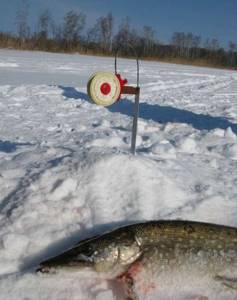
The largest pikes rarely feed on small things or do not feed on them at all (too much energy expenditure during hunting, and the protein intake is insignificant). But, of course, a lot here depends on the food supply of the reservoir. Thus, on many lakes in the Tver and Novgorod regions, large pike often follow schools of small bream, which, even in tributaries or narrow elongated bays, usually stick to the channel, rarely reaching shallows with clear water (sometimes it happens at the very end of freeze-up).
In this regard, at the end of the freeze-up, you should not focus only on extremely shallow water, but also choose deeper places. For example, in March on Lake Shlino in the Tver region there are a lot of pike in the upper reaches of the bay, where the main influx flows. At this time, schools of a wide variety of forage fish gather here: roach, bream, ide, dace, bleak, and silver bream.
The fish that survive in the watering are mostly small, and pike are more often found here weighing up to 1.5 kg. But on the edges, where the depth is 1–2 m and where a decent bream is biting, you can catch “toothy” and larger ones, which is due to the entry of schools of large bream along the riverbed (movement along the tributary is limited by a dam through which the passage pipe passes).
However, in the spring, a large number of fishermen can appear on the ice of shallow fishing bays, and pike, especially large ones, do not like noise. Therefore, at the beginning of the “white” fish’s run, you can end up with a “toothy” catch, but later you won’t even get away from zero.
When it gets colder, pike coming out to hunt in shallow waters can again move to depths of 5–6 m, or even more. In general, I noticed that on large lakes and reservoirs, even at the end of the freeze-up, some of the schools of large “white” fish remain on feeding underwater hills remote from the shore or in irrigation areas near a flooded riverbed, and large predators often feed here: pike, perch, burbot. Therefore, if the pike does not take near the shore, and the ice is still strong, I sometimes go to check the deep waters known to me.
By the way, these water areas may not be so far from the coast. For example, at one time I often fished in the tributaries of the Vazuz Reservoir, usually placing vents along the watering holes and edges of the flooded tributary channel, often focusing on individual snags. Here, the depth of setting the girders was 0.2–1.5 m and medium-sized pike were caught predictably.
But in that place the reservoir is quite narrow, and from the area where shallow water vents were placed to the edge of the main channel there was no more than 200–300 m, so I placed some of the vents at depth. And although at depth the bites were much less frequent, there were specimens there that were much larger than the mass of those caught in the shallows; At the same time, there was also a pike perch on the edge. By the way, pike and pike perch bites on the edges often occurred in the dark.
When searching for pike exit points in the spring, you should also focus on other areas:
- slopes of coastal and island sandy-rocky spits;
- edge of algae (cattail, arrowhead, pondweed) - around the islands and near the shore;
- long or short stretches of reeds;
- ditches near the shore (running along it or perpendicular to it);
- shallow channels between the shore and the islands;
- coastal dumps.
In such areas, the vents are installed at different depths.
How to make a vent yourself
A piece of plastic (light but durable) tube with a diameter of 3 - 5 cm and a length of 25 - 30 cm in the middle (not reaching the edges 4 - 5 cm) is wrapped in one layer of electrical tape (so that the cord does not slip). At one end of the tube, two through holes are made: one for a piece of cord or a piece of wire, with which the pole will be attached to a pole or branch of a bush near the reservoir, the second - for fixing the end of the cord, which will be wound around the middle of the tube. At the second end of the tube, a narrow notch is made to pinch the second end of the cord.
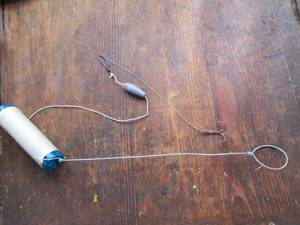
A cord 15-20 meters long is attached at one end to the tube and wound evenly around its middle. The second end of the cord is fixed in the cut, which does not allow the cord to unravel spontaneously. A metal (titanium) leash is tied to this end of the cord, and a double or triple hook is attached to the other end of it.
Installation of tackle and equipment
The last ice can be loose, and the girders on it are unstable, so I use girders with a wide plastic base. They fold compactly into the bag designed for them. The tip of the signal plate of the flag must be bent so that twitching of the live bait does not lead to idle bites, but at the same time there should not be strong resistance to the plate, since in the spring the pike is very sensitive.
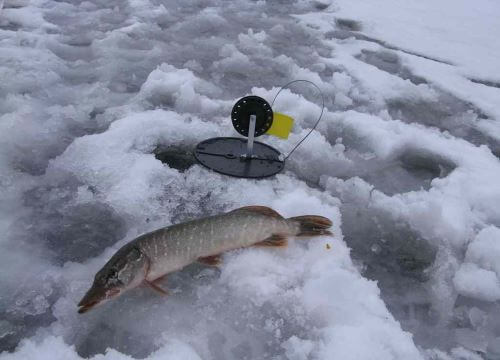
For fishing at depths from 1 to 6 m, I use conventional equipment with a “Cheburashka” sinker weighing 10–20 g, which, depending on the size of the baitfish, will allow it to move in wide circles to better attract a predator. In this regard, you should approach the holes every half hour and, without disturbing the tension of the flag plate, pull the fishing line (the holes should be covered with snow). If the pike takes very sluggishly and often throws live bait, then the weight of the sinker needs to be extremely reduced (sometimes it is enough to pin a few pellets on a soft fishing line so that they allow the bait to go to depth).
When fishing on marginal shallows, it is better to use equipment without a sinker, since here, due to the limited space, it will interfere with the movements of live bait. A rig without a sinker allows the fish to swim freely, either rising under the edge of the ice or sinking to the bottom. Without a sinker, the rig has to be pushed under the ice with a wooden flyer.
In the spring, as already mentioned, the pike becomes very sensitive, so a metal leash will be superfluous. The tee is tied directly to the main line with a diameter of 0.38–0.4 mm. It is desirable that the line be soft and without memory, then it twists less in rings and is better stretched into a line under the weight of live bait or live bait and sinker.
In this case, to prevent the pike from biting off the leash, after the bite you need to give it the opportunity to unwind the line and stop, and when it moves again, hook it. After this, do not fish immediately, but pull back a couple of tens of centimeters of the fishing line so that it can go behind the so-called pike whisker - this will prevent the fishing line from getting on the sharp teeth of the predator.
In the spring, you also need to have at least a dozen under-ice fishing poles in your fishing arsenal. Their design is simple and does not take up much space in the fishing box. But these supplies help out during night fishing. At night in March there are still severe frosts, and since due to the lack of snow cover there is nothing to cover the holes with, the fishing line of ordinary fishing rods freezes to the ice; at the same time, the unwinding of the under-ice vents is carried out without hindrance.
Pike in the spring - how this fish behaves
By the beginning of spring, even before the ice breaks up, pike move closer to the shore, where they can profit from the flocks of young fish gathering in schools and take a sip of oxygen from the wastewater. By the beginning of spawning, she needs to fatten up, and during this time she changes the usual way of life of a hunter in ambush . Sometimes, in order to grab a roach, it goes to a depth that barely covers its body.
During this period of pike activity , “pikemen” come out onto the browned spring ice with dozens of girders in their backpacks, eager not to miss the moment and acquire several trophies obtained with considerable difficulty.
Which live bait to choose
The universal pike bait for most reservoirs is roach or perch. They are playful and move a lot. Usually schooling roach and perch are well caught using a jig with bloodworms. If you caught live bait right before setting the poles, then it will run better on the rig than live bait brought in the eland.
Ruff, gudgeon, and bleak can also be good live bait. The good thing about gudgeon and ruffe is that, being above the bottom, they always try to go down and with their vibrations attract pike from afar. The bleak is also very mobile. Sometimes, to catch large pike, anglers bait bait with bream.
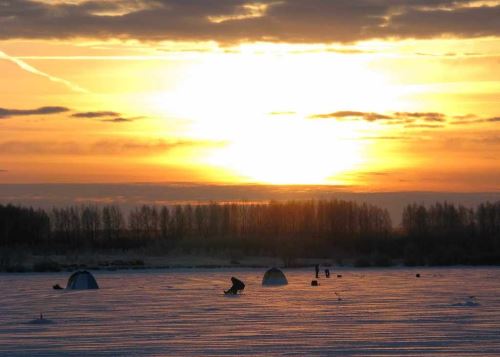
Small crucian carp are often on sale. It is very tenacious, but pike do not always like it. I usually take a dozen crucian carp with me and bait the bait with them so as not to waste time fishing with a jig, because in the spring the pike starts fishing early in the morning. After installing the girders, I begin to catch perches and roaches somewhere nearby using a jig, and gradually replace live bait, releasing crucian carp into the pond.
In general, it is better to release any live bait remaining on the hook into the reservoir, and not leave it to be eaten by crows. In order for the live bait to remain mobile for a long time, you need to select tees made of thin wire and make a delicate puncture behind the dorsal fin with a hook.
How to bait live bait
Since catching pike on a river in summer is a passive activity rather than an active one, the live bait must remain mobile for a long time. You need to hook it so that it does not jump off and remains an attractive bait for a predator for a long time. You can carefully pass the leash through the entire fish, or you can hook the fry by the gills.
In any case, summer pike fishing is an exciting and rewarding activity. And the best place to catch a predator is in the grounds of Sazanya Bay.
Tactics and fishing techniques
In spring it dawns early, so you need to be at the pond by six or seven o'clock. If fishing takes place on coastal shallows, then I focus on coastal slopes free of snow. Where there is a lot of it along the banks, the coastal water becomes cold due to snowmelt and less comfortable for feeding fish and predators.
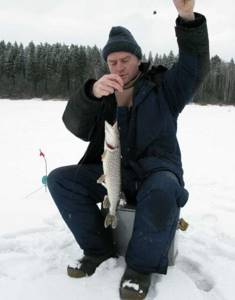
In this regard, when fishing near the mouths of tributaries, you should focus on those streams and rivers that do not flow through the forest, but through fields where the snow has already melted and whose water warms up well in the sun.
In the selected areas, I immediately drill holes in an amount twice as large as the number of holes. This is necessary so that during the fishing process it is possible to rearrange the girders without creating additional noise by drilling.
In addition, if a “toothy” one is caught on one of the girders, then it is useful to install one or two more girders closer to it: often other pikes are caught in the catchable zone. When fishing in shallow waters, you should move very quietly. If the girders are silent for a long time, it is worth taking out the girder equipment and playing for a while in the hole with a spoon - in different layers of water.
When searching for pike exit sites, the girders need to be spaced widely, but when the places where pike exits are well studied, the girders are placed close to each other.
In the spring it often happens that pike take sluggishly. If the pike grabs the bait, but does not turn it over and does not move to the side, you can force it to become more active if you finely tug the fishing line. Sometimes such twitching has to be done in several stages until the predator begins to properly unwind the tackle. A weak pike sometimes gets caught over the edge of its mouth.
When setting up the girders, you need to take into account that in March it usually freezes at night and a reliable crust forms on the ice, capable of supporting even a person, but the rising sun gradually destroys it and then not only the fisherman, but also the girders begin to fall through the ice. At the same time, the crust remains reliable longer under the shady shore. If possible, the girders should always be covered with snow.
Best time of day to fish with live bait
Fishing for girders is not always purposeful. Many ice fishing enthusiasts use postavushas as additional gear, which sometimes brings a good bonus to the main catch in the form of pike. It is advisable to approach toothfish fishing with live bait by going out onto the ice in the evening and staying overnight.
To learn more:
Catching Black Sea shrimp - the best ways
In a few hours of daylight, you can identify the most promising points and leave gear there. It is uncomfortable to spend the night on the shore of a winter pond, so you can wait out the darkness either in a car or in a rented house at a nearby recreation center. Checking in the morning usually pays off. It's nice to start fishing by catching a pike. Its activity during the first ice lasts until noon, and in the dead of winter it may be completely absent. At lunchtime, small things up to half a kilogram are mostly caught on the hook. In the evening the bite resumes, but does not last long.
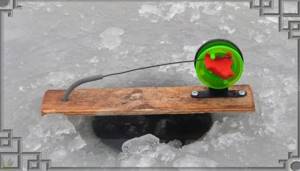
Homemade girder
Ice safety
Spring ice is treacherous. It happens that in the morning it calmly withstands the fisherman’s weight, but as the sun warms up it becomes loose and very unreliable, so you should always go fishing on the last ice with a friend who, if something happens, can throw the end of a long rope.
You should move along the very last ice, probing the ice in front of you with an ice pick, and it is advisable not to move far from the shore. It must also be remembered that ice is more reliable on well-trodden paths than on untrodden areas.
